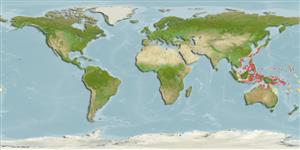Classification / Names
Common names from other countries
Main reference
Size / Weight / Age
Max length : 6.5 cm TL male/unsexed; (Ref. 90102)
Environment
Marine; reef-associated; depth range 1 - 10 m (Ref. 86942)
Climate / Range
Tropical, preferred ?
Distribution
Short description
Dorsal
spines
(total): 6 - 7;
Dorsal
soft rays
(total): 13;
Anal
spines: 1;
Anal
soft rays: 12. Characterized by generally whitish body color with three black stripes on upper two-thirds of head and body; presence of diffuse narrow bars on side; first and second dorsal fin equal in height; rounded caudal fin; longitudinal scale series 60; fully scaled predorsal region; scales dorsally on opercle, absent on cheek; ctenoid body scales; cycloid scales on nape, abdomen, and opercle; depth of body 4.5-4.8 in SL (Ref. 90102).
IUCN Red List Status (Ref. 115185)
Threat to humans
Harmless
Human uses
More information
Common namesSynonymsMetabolismPredatorsEcotoxicologyReproductionMaturitySpawningFecundityEggsEgg development
ReferencesAquacultureAquaculture profileStrainsGeneticsAllele frequenciesHeritabilityDiseasesProcessingMass conversion
Tools
Special reports
Download XML
Internet sources
Estimates of some properties based on models
Phylogenetic diversity index
PD50 = 0.5001 many relatives (e.g. carps) 0.5 - 2.0 few relatives (e.g. lungfishes)
Trophic Level
2.8 ±0.3 se; Based on size and trophs of closest relatives
Resilience
High, minimum population doubling time less than 15 months (Preliminary K or Fecundity.)
Vulnerability
Low vulnerability (14 of 100)
Price category
